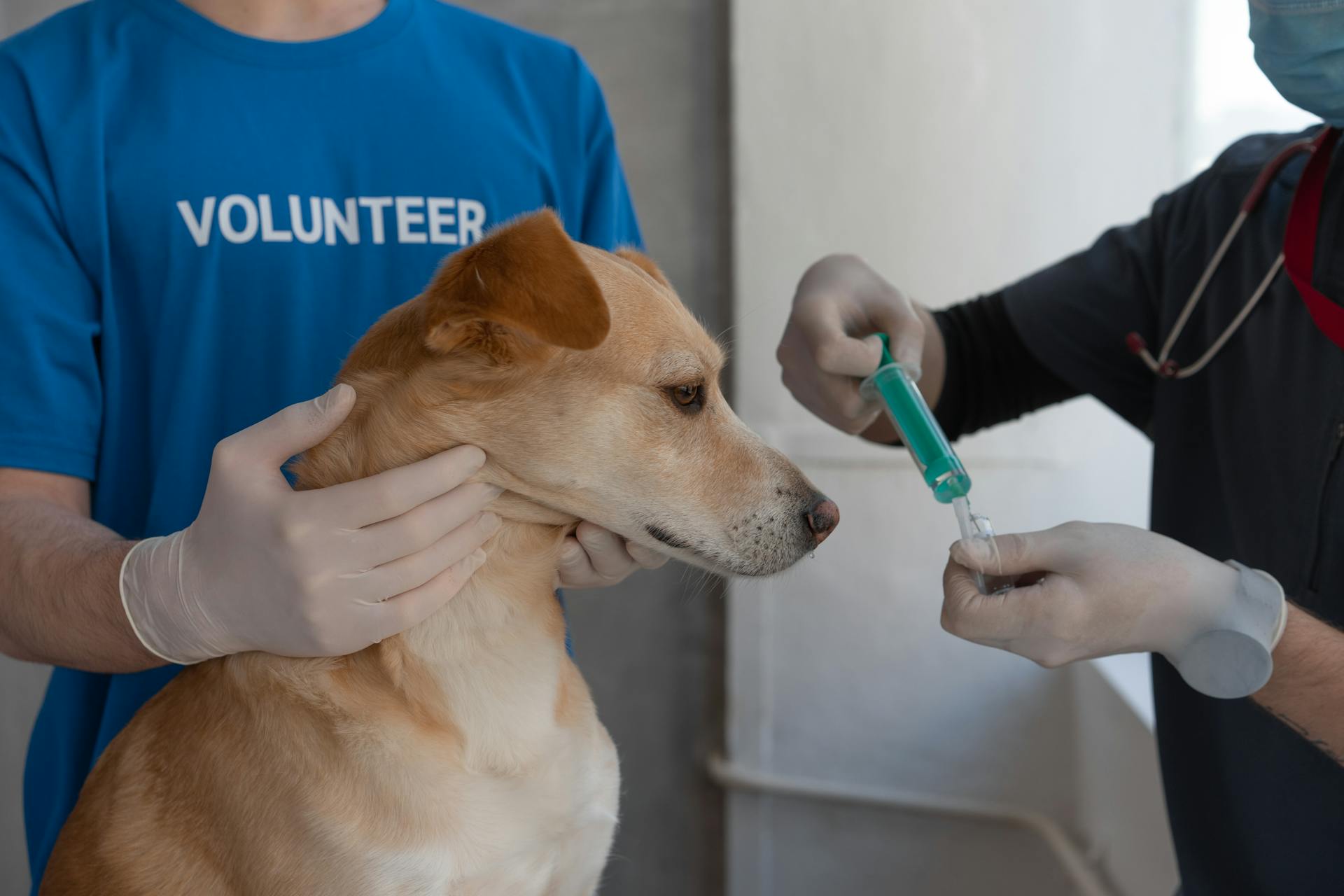
Canine bladder cancer is a serious health issue that affects many dogs. It's essential to understand the different stages of this disease to provide the best possible care for your furry friend.
The American Veterinary Medical Association (AVMA) identifies four stages of canine bladder cancer: Stage I, Stage II, Stage III, and Stage IV. Each stage has distinct characteristics that determine the prognosis and treatment options.
As the cancer progresses, it can invade surrounding tissues and organs, leading to more severe symptoms. In Stage II, the cancer has grown beyond the bladder muscle and into the surrounding connective tissue.
Symptoms can vary depending on the stage, but common signs include frequent urination, blood in the urine, and abdominal pain.
You might enjoy: Symptoms of Canine Bladder Cancer
Diagnosis and Evaluation
A diagnosis of canine bladder cancer requires a combination of tests, including urinalysis, urine sediment cytology, bladder tumor antigen testing on a urine sample, ultrasound of the urinary bladder and urethra, and biopsy of the affected area.
To determine the extent of the tumor, a process called tumor staging is performed. This involves radiographs of the thorax to look for lung metastasis, radiographs and ultrasound of the abdomen to look for metastasis in the abdomen and to assess any changes in the kidneys that result from obstructed urine flow, and imaging of the bladder to determine the exact location and size of the tumor within the bladder.
Your veterinarian may suspect a urinary tract tumor if your pet experiences recurrent urinary tract infections or the infections do not resolve with treatment. In this case, abdominal radiographs or ultrasound are usually recommended to determine the cause, such as an abnormal mass in the kidneys, bladder, or elsewhere along the urinary tract.
A biopsy is a surgical excision of one or more pieces of the abnormal tissue or tumor. This biopsy is then examined by a veterinary pathologist under the microscope. This is called histopathology. It's not only helpful to make a diagnosis but can also indicate how the tumor is likely to behave.
Tissue samples of any bladder or urethral masses can be obtained by catheterization. This involves placing a urinary catheter into the urethra to retrieve potentially cancerous cells from the lining of the urethra or bladder. Another diagnostic option is cystoscopy, which involves passing a small scope (tube with camera) into the urethra and into the bladder to examine these areas, as well as obtain tissue biopsies for a pathologist to review.
Expand your knowledge: Mast Cell Tumor Boston Terrier
Here are the diagnostic tests used to diagnose bladder cancer in dogs:
- Urinalysis
- Urine sediment cytology
- Bladder tumor antigen testing on a urine sample
- Ultrasound of the urinary bladder and urethra
- Biopsy of the affected area (sometimes)
It's worth noting that there is a urine test for a specific mutation in the BRAF gene in the bladder cancer cells. This test may be recommended by your veterinarian or veterinary oncologist.
You might like: Canine Parvovirus Test
Signs of
Signs of canine bladder cancer can be subtle, but knowing what to look for can help you catch the disease early. Blood in the urine is a common sign, as well as straining to urinate and making repeated frequent attempts to urinate.
Dogs may also have urinary accidents in the house, which can be a sign of bladder cancer. However, it's essential to remember that these symptoms can also be caused by urinary tract infections, so it's crucial to seek veterinary care to determine the cause.
In addition to these symptoms, dogs with bladder cancer may also experience difficulty urinating or have accidents in the house. Discolored or bloody urine can also be a sign, and persistent urinary tract infections that are resistant to treatment can be a red flag.
As the disease progresses, dogs may experience lameness due to the cancer spreading to the dog's bones or lungs. In the later stages of bladder cancer, some dogs may have a paraneoplastic syndrome called hypertrophic osteopathy, which can cause lameness.
Here are some common signs of bladder cancer in dogs:
- Inability to urinate
- Difficult urination
- Blood in the urine
- Urinary incontinence
Remember, if your dog is displaying any of these symptoms, it's essential to seek veterinary care as soon as possible. The symptoms of bladder cancer can be caused by a number of serious conditions that require treatment.
Treatment and Care
Treatment options for canine bladder cancer depend on the stage and grade of the tumor, as well as the dog's overall health.
Surgery is often the primary treatment for canine bladder cancer, and it can be performed to remove the tumor, the bladder, or other affected organs.
Chemotherapy and radiation therapy may be used in combination with surgery to kill any remaining cancer cells.
Consider reading: Mast Cell Tumor in Pit Bulls
Prognosis and quality of life for dogs with bladder cancer can be improved with proper treatment and care, but it's essential to work closely with a veterinarian to determine the best course of action.
With proper care and management, some dogs with bladder cancer can live for several months to a year or more after diagnosis.
Radiation Therapy
Radiation therapy is a treatment option for bladder cancer in dogs. It has been used to successfully control the growth of transitional cell carcinoma (TCC) in the bladder.
Radiation given in traditional doses can lead to complications such as a scarred, shrunken bladder and irritation to surrounding organs. The bladder's movement and changing shape make it a challenging area to target with radiation.
With better imaging, radiation therapy of the bladder has become much safer than in years past. The optimal treatment protocols and the level of benefit offered by radiation therapy require further study.
TCC Symptomatic Care
As your dog's condition progresses, it's essential to understand the changing symptoms of TCC. Inability to urinate is a common symptom that can be challenging to manage.
If your dog is experiencing difficulty urinating, it's crucial to seek veterinary care immediately. This symptom can be a sign of a more serious issue.
Blood in the urine is another common symptom of TCC. This can be a distressing sign for both you and your dog.
Urinary incontinence is also a symptom of TCC. This can lead to accidents in the house, which can be frustrating and messy.
Here are some common symptoms of TCC as the disease progresses:
- Inability to urinate
- Difficult urination
- Blood in the urine
- Urinary incontinence
Monitoring and Prognosis
Monitoring changes in tumor size is crucial in canine bladder cancer, as symptoms don't always follow changes in tumor size. Measuring the tumor before and after treatment is essential to determine if the treatment is working.
If the tumor is shrinking or remaining stable in size after 4-8 weeks of treatment, and the dog is feeling well, the same treatment is continued. However, if the cancer is not responding, a different treatment is initiated.
The prognosis for dogs with bladder cancer varies greatly depending on the extent of the disease, its location, and the treatment chosen. With surgical intervention, an attempt is made to remove as much of the tumor as possible to increase survival time.
Discover more: Lifespan of Dog with Mast Cell Tumor
Monitoring Plan
At Purdue University, the typical plan for monitoring dogs with Transitional Cell Carcinoma (TCC) involves measuring the tumor before treatment, and then remeasuring it after 4-8 weeks of treatment.
This is crucial because a dog's clinical signs, or symptoms, don't always follow changes in tumor size. If a dog develops a urinary tract infection, their symptoms will be much worse, yet the tumor might not be growing.
The size of the tumor is an important indicator of how well the treatment is working. If the tumor is shrinking or remaining stable in size after 4-8 weeks, and the dog is feeling well on that therapy, then the same treatment is continued.
However, if the cancer is not responding, or if the dog doesn't feel well on that particular treatment, then a different treatment is initiated. After each 4-8 weeks of treatment, the tumor is remeasured to confirm the treatment is still beneficial and to alter therapy as indicated.
TCC Prognosis
The prognosis for dogs with TCC varies greatly depending on several factors, including the growth rate of the tumor, its location, and whether it has spread to other organs.
Survival rates can range from a few days to over two years, with some dogs living longer with more aggressive treatment protocols.
Early studies showed a dismal prognosis, with some dogs living only 109 days after diagnosis. However, with advancements in treatment, median survival times have improved to 244 days with piroxicam treatment and 299 days with vinblastine and piroxicam.
Factors that negatively affect survival time include extensive tumor growth within the bladder, spread of the tumor beyond the bladder, and involvement of the tumor in the prostate gland.
Approximately 20% of dogs with TCC have detectable metastasis at diagnosis, and 50-60% have metastasis at death.
Despite progress in treating TCC, there is still much to be learned, and ongoing clinical trials aim to improve treatment efficacy and patient outcomes.
With appropriate treatment, many dogs with bladder cancer can survive for 6-12 months after diagnosis, and some may even live longer with more aggressive treatment protocols.
Intriguing read: How Fast Does Lymphoma Grow in Dogs
Frequently Asked Questions
What are the final stages of bladder cancer in dogs?
Final stages of bladder cancer in dogs can be fatal if left untreated, and may also cause breathing difficulties, nausea, vomiting, and loss of appetite due to tumor spread to the lungs and liver
How aggressive is bladder cancer in dogs?
Bladder cancer in dogs is an aggressive form of cancer that can quickly spread to other parts of the body. Its aggressive nature makes prompt treatment crucial for managing the disease.
Sources
- https://vcahospitals.com/know-your-pet/urinary-tract-tumors
- https://vet.purdue.edu/wcorc/cancer-research/canine-urinary-bladder-cancer-research.php
- https://www.northeast-vet.com/site/pet-care-blog-plains-vet/2020/10/29/bladder-cancer-in-dogs
- https://www.petmd.com/blogs/fullyvetted/2012/july/canine_bladder_cancer-26371
- https://www.huntersville.carolinavet.com/site/huntersville-veterinary-blog/2020/09/11/bladder-cancer-in-dogs
Featured Images: pexels.com


